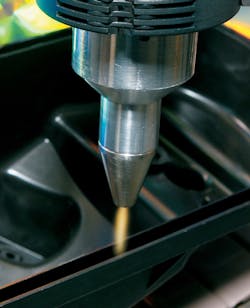“Companies in the medical, automotive, packaging, consumer products, wire & cable, sporting goods, furniture, folding carton, and others markets find that surface treatment improves bond strength, increases throughput, and can also reduce cost,” says Mark Plantier, vice president of marketing for Enercon Industries Corp. (Menomonee Falls, Wis.) The company's product line includes the Dyne-A-Mite HP, Dyne-A-Mite IT, Dyne-A-Mite VCP, and Plasma3 atmospheric plasma systems, as well as the Dyne-A- Flame surface treater featuring PowerFlame burner technology.
Flame and atmospheric plasma are the two surface treatment technologies. “Flame can be used to treat both small and large surface areas with burner designs available in widths to match the specific application,” explains Plantier. “While combustion control technology ensures modern flame treaters provide repeatable treatment results, a series of interlocks are used for safety. System integrators incorporate these interlocks into the overall work cell, which can vary from basic to quite elaborate.”
Atmospheric plasma systems are different from flame systems in that they do not require gas, operate at lower temperatures, and offer options for variable chemistry plasma for difficult-to-treat applications.
Because the relationship between the surface treating equipment supplier and the system integrator is critical to an end user’s ultimate satisfaction, Enercon has partnered with system integration companies to meet end user needs. “It’s essential for the integrator to gain an understanding of the surface treating equipment selected for the application,” says Plantier. “Variables to be taken into account include dwell time, and the distance required between the surface treating head and the surface to be treated.”
Jerry Schmit, senior applications engineer for Midwest Engineered Systems Group (Pewaukee, Wis.), said his company partnered with Enercon for an automotive parts application that required flame plasma surface pretreatment prior to applying an adhesive.
The customer needed to flame treat two very different parts, said Schmit. The system requirements in this case included building a safe system that utilized robotics for efficiency and repeatability that could deliver a part-to-part cycle time of 60 seconds or less, and achieve an inherent surface energy (also called a dyne level) of 50 dynes or greater. (A list of the automation components of that system is shown in the box below.)
Midwest developed a program that allows operators to scan a unique a bar code for each part, which automatically loads the correct program. “The material handling component uses sensors to verify the correct part is in place, in this case a dashboard,” says Schmit. “The part is presented to the robot, the flame treater is activated, and a multi-axis robot executes a path enabling the treatment head to follow a precise treatment pattern for the part. While the robot is flame treating the parts, the operator is able to load another part onto the open fixture. This enables continuous operation of the system and optimizes the cycle time from part to part.”
Each customer’s requirements are unique to their operation and available space, adds Schmit. “We’ve had projects where we’ve integrated an Enercon flame treater with a conveyor, and we’ve also constructed entire rooms where parts are transported in, treated and then exit the room for additional processing. We enjoy working with Enercon because of their depth of knowledge in surface treating."
|
Automation Inside: Automotive Parts Flame-Treatment System Midwest Engineered Systems Group designed and integrated the automotive parts flame-treatment system using the following automation components: Robot: ABB Robotics Flame Treater Power Supply and Burner Head: Enercon Industries Bar Code Scanner System: STD range multi interface unit Part Presence Sensors: Efector 2-Position, Motor-Driven Turntable: Omni Conveyor Systems Main System PLC: Rockwell Automation Allen Bradley Main System Human Machine Interface: Rockwell Automation Allen Bradley Panelview Safety Fence Guarding System: Axelent Guarding with Rockwell Automation Allen Bradley Interlock Door Switch Operator Light Curtain Safety System: Omron STI Custom End of Arm Tool (EOAT) to mount flame treater head: MWES Engineering Custom Unitized Base: MWES Engineering Custom Fixturing and Tooling: MWES Engineering Custom Exhaust Hood with Inline Blower: MWES Engineering |
Renee Robbins Bassett, [email protected], is Managing Editor of Automation World.
About the Author
Renee Bassett
Managing Editor

Leaders relevant to this article:
